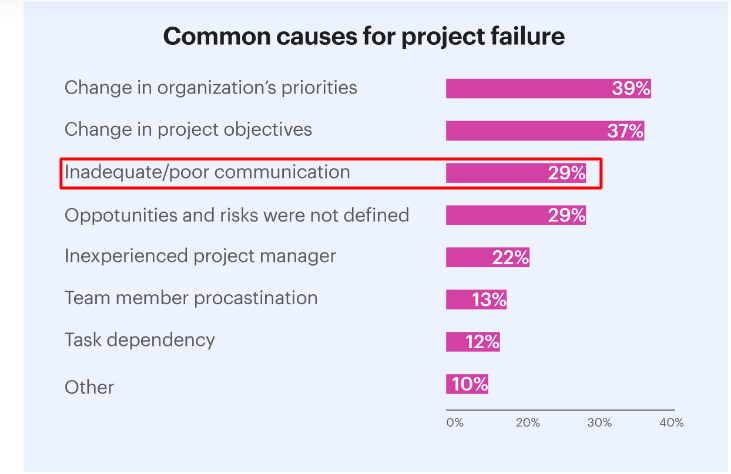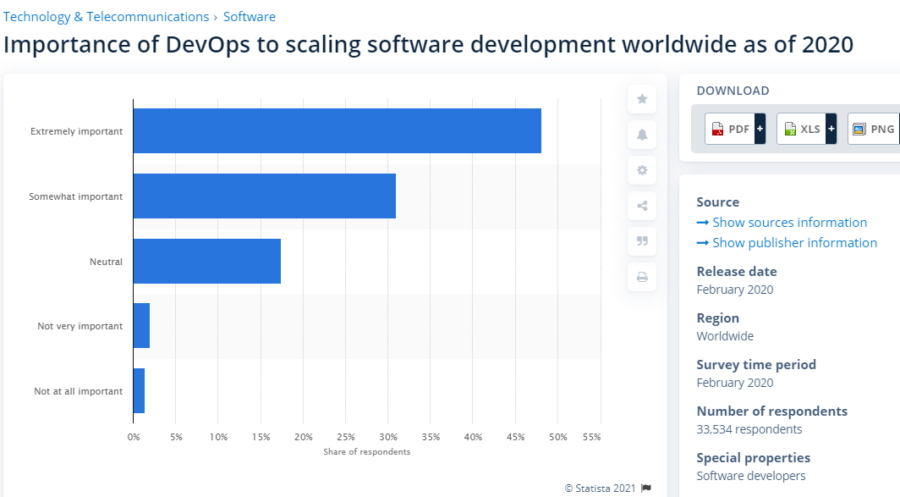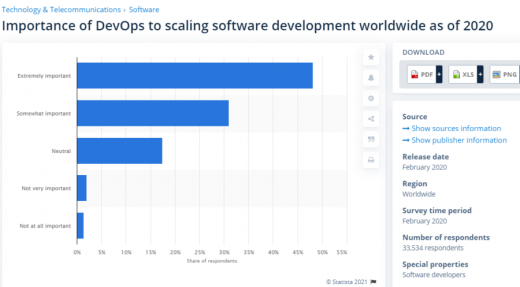How DevOps Has Emerged to Be the Bed-rock Tool for Software Development Businesses

Source: Unsplash
Non-collaboration is one of the worst human failings. And the only way to fight this failure is through collaboration.
Software Development teams struggled with their non-collaborative mindset some time ago. They always kept the testing and operations team at a distance, like an all-authority figure handing down information from the top, which resulted in botched software deployments and unhappy customers.

Source: Kissflow.com: common causes of project failure
The massive setbacks caused due to poor collaboration between teams got the organizations thinking of a solution like a dog with a bone. This was when a solution called DevOps appeared out of thin air. As in, the philosophy, or you could call it a practice, with collaboration as its central theme, was the missing link. So, all they had to do now was to give this missing link a concrete shape in the form of DevOps.
According to this new-found practice, the development teams were not allowed to work in isolation; instead, they had to join forces with the IT operations team and testing teams to ensure impeccable software development and delivery in sync with customer requirements.
Long story short: DevOps enables collaboration of development, testing, and deployment teams to streamline the development processes by plugging in the gaps.
“True progress in any field is a relay race and not a single event “- Author Cavett Roberts
This article attempts to flesh out DevOps in detail and how it has emerged as a bed-rock tool for software businesses’ smoother functioning.
First off, let’s start with the definition of DevOps:
I. DevOps Definition in brief
For starters, DevOps is a combination of software development best practices that improve the overall collaboration process between Software development teams (Dev), Testing Teams, and the IT teams (Ops). The collaboration speeds up the development cycle and ensures faster delivery of features, updates, fixes, and so forth in sync with the business objectives.
This results in an ongoing feedback loop leading to a series of improvements, developments, testings, and productions, causing continuous feature releases and updates for software products.
II. DevOps History
As it turns out, the concept came around in 2007 and 2008 when IT operations and software development teams had a siloed existence. Their objectives varied, their KPIs varied, their leadership styles differed, and so on. This resulted in development teams hiding behind the impenetrable walls of convoluted codes that the operations team invariably failed to decode. Not surprisingly, the codes were labeled as impractical and unsuitable for deployment.
This was when DevOps came as a saving grace for the businesses. Through DevOps, the development team and operation team decided to sort things out among themselves. Evangelized by experienced software developer Andrew Clay and Belgian consultant and agile practitioner Patrick Debois, the concept initially started as a tiny spark of fire in the on-line forums and local meet-ups. It then began breaking new grounds after a DevOps day event held in Belgium in 2009.
III. DevOps Adoption Rate
In 2019 DevOps market size surpassed USD 4 billion, and by 2020-2026 it is expected to grow at over 20% CAGR. The advancements in automated software development and zero-touch automation technologies would be the wind behind the DevOps wings as we advance.

Source: Gminsights
Statista survey 2020 reports the following trends
As per the survey, almost half of the respondents considered DevOps extremely important, while 80% believed DevOps is somewhat essential.

importance of Devops world-wide
- Businesses using DevOps can deploy codes 30 times more frequently
- And the code pushes are 50% less likely to fail
IV. DevOps Resourcefulness
Businesses cannot think of development without DevOps these days. Read more about DevOps resourcefulness here.
#1. Collaboration between cross-functional teams
As you already know by now that DevOps rhymes with collaborations. The three different teams were brought together under one umbrella called DevOps to ensure around-the-clock communication, collaboration, and integration. All the team members have to look over their shoulders time and again to ensure that the quality and deadlines of deliverables are met.
#2. Conducive Working Environment
When teams learn to collaborate, the atmosphere in the cubicles improves. Completing one another becomes the sole goal rather than competing with one another. Teams grow more confident because they know that other groups have their back when things go wrong. This increases their confidence, and work efficiency ensuring faster development and deployment. More than anything, employees develop a sense of gratitude towards their peers. So, it comes as a little surprise that DevOps is considered to be an effective team management strategy.
#3. Focus on Innovation
King Solomon of ancient Israel observed: “Iron sharpens iron, so one man sharpens another.” The DevOps context could mean that when people from different teams brainstorm together, it could lead to many unique ideas worth exploring. This will help your business to grow and succeed. Some of the world’s best companies allocate particular time to their employees to innovate and build great products that give them an edge in the marketplace.
#4. Problem Solving
Process problems can leave a lot of money on the table. And the more time you take to address the problem, the more aggravating it becomes, thereby thwarting its growth. On the other hand, if you can solve problems quickly, the losses will be limited, and you’d be able to get your business on track sooner than later. So, if you are looking to solve problems faster than this, DevOps is the go-to tool.
V. 5 Steps to Devops Success
To map out your DevOps journey, first of all, you need to have a crystal clear idea about these three things:
- a) Business processes
- b) Delivery pipelines
- c) Objectives
Secondly, you need to choose the deployment process:
- Greenfield deployment or
- Brownfield deployment
For the uninitiated, Greenfield deployment involves developing software from scratch without depending on any legacy code. Nevertheless, with several development options available to pick and choose from, it becomes challenging to decide on a suitable approach making it a time-consuming process.
Brownfield deployment, on the other hand, is the development and deployment of software using legacy software. This method is best when you want to update an existing application using an already existing code. However, as you need a thorough understanding of the legacy code, this method could prove time-consuming and costly.
Whichever model you choose, it’s always nice to test-drive the project first. And if you wish to launch the product faster, you can select the iterative DevOps model, which comes with strict deadlines.
#1. Gear Up for a Monumental Cultural shift
Devops is gonna turnaround your workplace culture upside-down. So, are you prepared for it? In other words, development, testing, and operations teams won’t be allowed to work in isolation anymore. They will have to bridge their differences, no matter what, and get along with each other as one unit.
So, the question remains the same? Will they be ready for such policy changes? Will they adopt a flexible mindset to cooperate as a team? More importantly, the one thing that they need to bear in mind is that such cultural policy changes aren’t temporary. These policies are going to be there forever. So, just going through motions won’t help. Superficial acceptance will only create more troubles in the future.
Additionally, successful DevOps require the cooperation of the top-level management teams and even the new recruits. No one can be exempted from it. So, before you embark on your devops adventure, developers and operations personnel should be informed about its resourcefulness beforehand and what it brings to the table.
Takeaway: DevOps means a substantial cultural shift. The central task of this stage is to keep your egos aside and get talking with several teams.
#2. Develop a “build-and-run” approach
Ok, as of now, your entire organization has decided to come together as one entity. Meaning the culture shift has begun. Good! Now let’s move towards the next step – forming a tunnel-vision around your DevOps teams. Why? It’s because the developers would be clueless initially as to how to about with their development process. More so because their ideas should be in sync with that of the operations team. Meaning, you will have to provide developers with accurate, up-to-date information about the production environment to ensure a seamless deployment. In other words, developers will have to adopt a “build and run” approach, in which the developers will have to take complete ownership of the product or service and see it through the production phase. The ownership could be for a specific period or forever. This helps address bugs then and there. The idea is to lend the operations team a helping hand when the bugs arise.
During this stage, the DevOps team takes care of planning, deployment, and maintenance. With in-depth knowledge of the platform, the DevOps are well-equipped to debug problems easily – a function that’s managed mainly by the operations team so far.
Beyond what I said so far, this stage focuses on creating an automated deployment pipeline, whereby an automated script can be deployed in any environment in minutes. Such a channel should enable non-stop integration, development, testing, and deployment.
Takeaway: DevOps leads to setting up an automated deployment pipeline, which ensures that the script could be deployed in any environment in no time. Such a pipeline bolsters the process of non-stop integration, development, testing, and deployment.
#3. Non-stop Testing
Real-time feedback ensures real-time changes, which in turn provides better quality software. In the traditional waterfall process, the complete code passes through the development and testing phase. If the code passes through both these phases without any hiccups, it’s moved to the production phase without much ado. Contrarily, if the code fails the testing phase, then it needs to be sent to the development phase for editing. This consumes time and is considered unreliable.
Step in DevOps. In the case of DevOps, testing is synonymous with development. Both go hand in hand as QA people are an integral part of cross-functional teams. Both manual and automated testing is carried throughout the pipeline.
And the best part is that time between testing and release is shortened.
Tip: You can play safe by creating a minimum viable delivery model with just a single unit test to be made part of the automated deployment script. Going forward, you are free to add more tests throughout the delivery pipeline.
Takeaway: The QA team is part of the DevOps process, ensuring continuous testing of all features and updates.
#4. Non-stop Deployment
Even minimally build software that passes through the test cycle gets automatically deployed. There’s no human intervention involved to decide what to deploy and what not to. With non-stop deployment, organizations are free to make proactive improvisations in the product and then step on the gas to deliver new features and updates. Sure, the whole process may seem intimidating with so many improvisations and deployment involved and no human intervention. Notwithstanding the human intervention part, devops come with a well-designed delivery pipeline wherein specific implementations are made available to only Alpha or Beta testers.
This sort of non-stop deployment should be supported by real-time monitoring and feedback. Real-time feedback ensures that your improvisations are in keeping with the needs of the users.
Takeaway: The rapid development, quick deployment, and immediate feedback nature of SDLC combined with DevOps ensure all the glitches are repaired on time.
5. Adopt blue/green deployment
Facebook and Twitter are the two sites that use blue and green deployment. Businesses resort to such deployments to minimize downtime and risks. When changes are made per this method, both blue (new) deployment and green (old) deployments are triggered simultaneously. In short, both deployments run in parallel. In the early stages, minimal traffic is introduced to the blue deployment. And if the blue deployment is a success, then the rest of the traffic is also routed towards it, enabling the removal of green deployment. If it doesn’t work, then traffic is routed back to green, and blue gets removed.
Takeaway: Blue and Green Deployments minimizes downtime and risks.
VI. DevOps and Covid 19
It’s been more than a year now, and still, the pandemic shows no signs of tapering off.
However, thanks to IT’s nature, pandemic or no pandemic, business is as usual for this industry. Though employees are apparently cocooned at home, their efficiency has never been questionable. Notwithstanding their efficiency part, the question now is whether the businesses will be able to deliver software products and services on time to ensure business continuity amid ongoing pandemics?
The adoption of DevOps will assist companies in delivering products to end-users on time quickly. How, you may ask? It’s because it embraces automated software development that enables it to be used anywhere – both at the office and home.
What’s more, due to the looming economic uncertainty launching new software or service may seem like an impossible task. However, DevOps inspires businesses to take bolder decisions as the risk is not confined to one department but spread across the operations and the development team, ensuring they put in their best efforts and each department’s reputation is on the line.
VII. 10 Top DevOps Tools for 2021
#1. Slack
#2. Docker
#3. Jenkins
#4. Nagios
#5. Splunk
#6. Vagrant
#7. Ansible
#8. GitHub
#9. BitBucket
#10. Sentry
Implementing DevOps is the only way forward for businesses. Use it and see for yourself how much difference it will bring to your business. If you are interested in trying DevOps out, consult some top DevOps companies listed on GoodFirms. These companies are experienced enough to flesh out all the relevant details, which will help you decide whether DevOps is meant for you or not.
Business & Finance Articles on Business 2 Community
(35)


